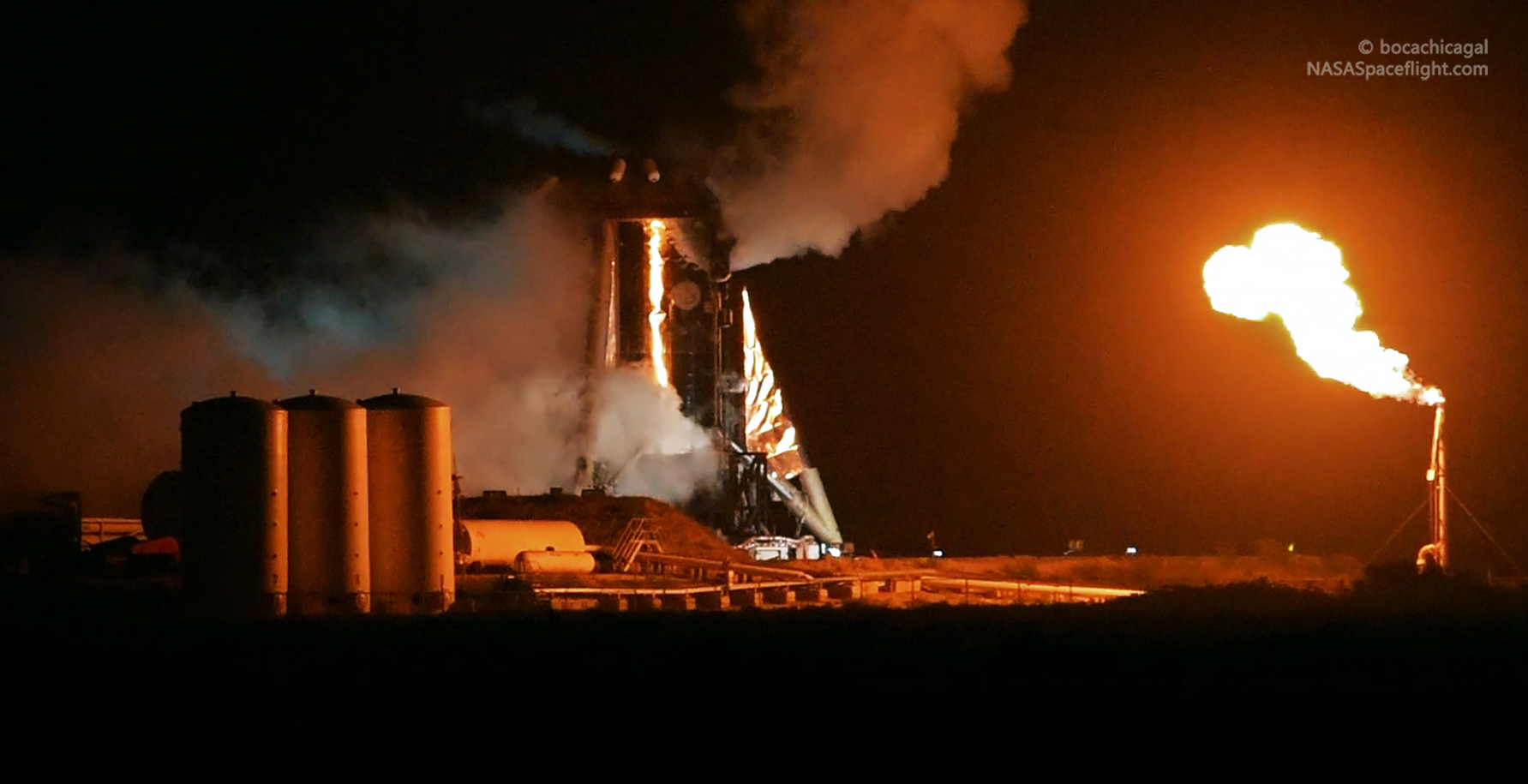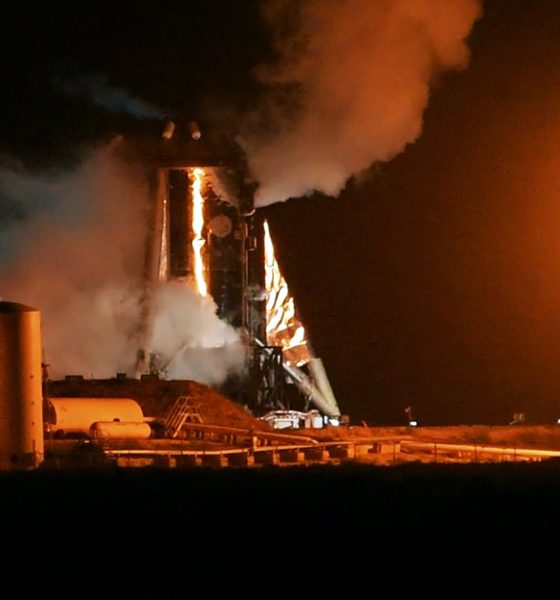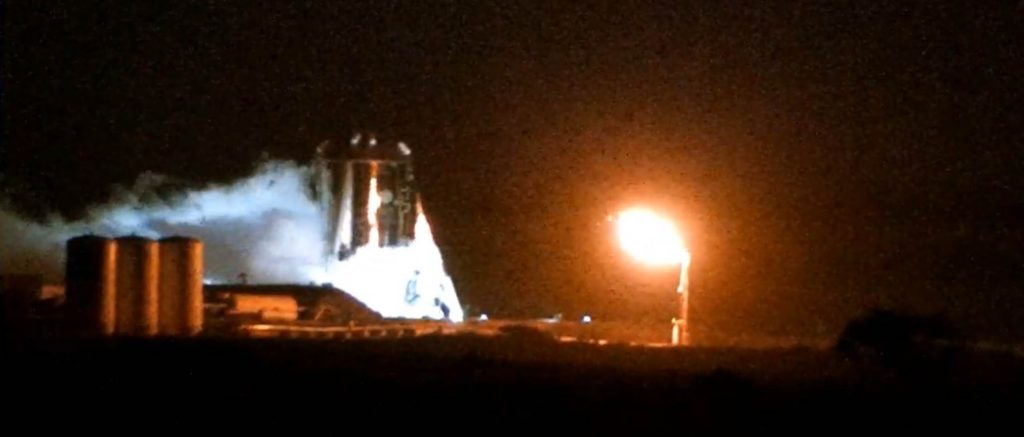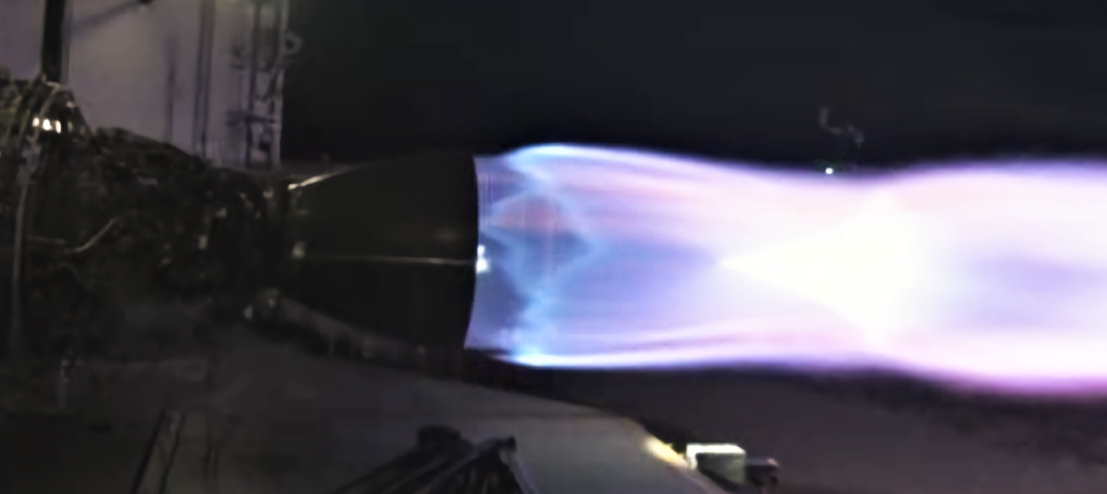

News
SpaceX delays Starhopper’s first flight a few days despite Raptor preburner test success
SpaceX has (partially) ignited Starhopper’s freshly-installed Raptor engine, successfully verifying that the engine is ready for its next major test: a full ignition and static firing. Although successful, SpaceX still has some work to do before the vehicle is ready for its first untethered flight(s).
July 15th’s progress is just the latest in a several day-series of preflight tests designed to reduce the likelihood that Starhopper is destroyed over the coming days and (hopefully) weeks. If all goes planned during the awkward Starship prototype’s first foray into hover tests, SpaceX CEO Elon Musk has stated that he will provide an official presentation updating the public on the status of the company’s ever-changing next-generation rocket.
The past week or so of Starhopper preflight testing began with Raptor serial number 6 (SN06) completing the last of a series of acceptance test fires in McGregor, Texas on June 10th. Even on its own, this was a major milestone for the new SpaceX engine: Raptor SN06 was the first of the new, full-scale engines to pass the acceptance test program with flying colors. According to Musk, for the engine to complete those tests so successfully, SpaceX had to solve a challenging bug in which some sort of mechanical resonance (i.e. vibration) damaged or destroyed Raptors SN01-05.
Hours later, the engine began a short ~450 mi (720 km) journey south to Starhopper, located in Boca Chica, Texas. The engine arrived on July 11th and was fully installed on Starhopper by the following evening (July 12th), at which point SpaceX put Starhopper and Raptor through some mild but valuable thrust vector controller (TVC) tests, wiggling the car-sized engine to ensure it can accurately steer the prototype rocket.
Around two days after the above ‘wiggle’ test was successfully completed, SpaceX moved into the next stage, partially fueling Starhopper with liquid methane and oxygen propellant and helium pressurant in what is known in rocketry as a wet dress rehearsal (WDR). The (implicitly) successful WDR was capped off with a duo of what can now safely be concluded were some sort of Raptor test preceding even pre-ignition operations. Whatever the tests were, they appear to have been completed successfully.
That appears to be the case because less than 24 hours after their completion, on July 15th, SpaceX once again began loading Starhopper with propellant and pressurant for a second round of wet testing. This time around, SpaceX got right into more critical Raptor tests once enough propellant was loaded, igniting the engine’s interwoven oxygen and methane preburners.

Previously discussed 24 hours ago in a Teslarati article focused on Raptor wiggles and other miscellaneous tests, Raptor is an extremely advanced rocket engine based on a cycle (i.e. how propellant is turned into thrust) known as full-flow staged combustion.
“In a staged-combustion engine like Raptor, getting from the supercool liquid oxygen and methane propellant to 200+ tons of thrust is quite literally staged, meaning that the ignition doesn’t happen all at once. Rather, the preburners – essentially their own, unique combustion chambers – ignite an oxygen- or methane-rich mixture, the burning of which produces the gas and pressure that powers the turbines that bring fuel into the main combustion chamber. That fuel then ignites, producing thrust as they exit the engine’s bell-shaped nozzle.
Unintuitively, conditions inside the preburner – hidden away from view – are actually far more intense than the iconic blue, purple, and pink flame that visibly exists Raptor’s nozzle. Much like hot water will cool while traveling through pipes, the superheated gaseous propellant that Raptor ignites to produce thrust will also cool (and thus lose pressure) as it travels from Raptor’s preburner to its main combustion chamber. If the pressure produced in the preburners is too low, Raptor’s thrust will be (roughly speaking) proportionally limited at best. At worst, low pressure in the preburners can trigger a “hard start” or shutdown that could destroy the engine. According to Elon Musk, Raptor’s oxygen preburner thus has the worst of it, operating at pressures as high or higher than 800 bar (11,600 psi, 80 megapascals).”
In full-flow staged combustion (FFSC), even more complexity is added as all propellant that touches the engine must necessarily end up traveling through the main combustion chamber to eke every last ounce of thrust out of the finite propellant a rocket lifts off with. As such, FFSC engines can be about as efficient as the laws of physics allow any given chemical rocket engine to be, at the cost of exceptional complexity and brutally difficult development.
Additionally, FFSC physically requires two separate preburners and then makes things even harder by making each separate preburner (methane and oxygen) depend on each other’s operation for the engine to fully ignite. This means that no individual preburner can be used to kickstart Raptor – instead, SpaceX must somehow spin the turbopumps that feed propellant into each preburner with some separate system. This is all just to emphasize the fact that Raptor’s ignition sequence is a spectacularly complex orchestra of valves, spark plugs, sensors, and magic. This is why it’s valuable for Raptor to test its preburner system independently of an actual ignition test, at least as long as the engine is still in the development stages.

According to NASASpaceflight.com managing editor Chris Bergin, what this practically translates to is a minor Starhopper hover test delay of 1-2 days, while the static fire has also been pushed roughly 24 hours from July 15th to July 16th. If that full static fire produces lots of happy data, Starhopper could be cleared for a hover test debut attempt as early as Wednesday or Thursday (July 17/18).
Check out Teslarati’s Marketplace! We offer Tesla accessories, including for the Tesla Cybertruck and Tesla Model 3.

News
Tesla starts showing how FSD will change lives in Europe
Local officials tested the system on narrow country roads and were impressed by FSD’s smooth, human-like driving, with some calling the service a game-changer for everyday life in areas that are far from urban centers.

Tesla has launched Europe’s first public shuttle service using Full Self-Driving (Supervised) in the rural Eifelkreis Bitburg-Prüm region of Germany, demonstrating how the technology can restore independence and mobility for people who struggle with limited transport options.
Local officials tested the system on narrow country roads and were impressed by FSD’s smooth, human-like driving, with some calling the service a game-changer for everyday life in areas that are far from urban centers.
Officials see real impact on rural residents
Arzfeld Mayor Johannes Kuhl and District Administrator Andreas Kruppert personally tested the Tesla shuttle service. This allowed them to see just how well FSD navigated winding lanes and rural roads confidently. Kruppert said, “Autonomous driving sounds like science fiction to many, but we simply see here that it works totally well in rural regions too.” Kuhl, for his part, also noted that FSD “feels like a very experienced driver.”
The pilot complements the area’s “Citizen Bus” program, which provides on-demand rides for elderly residents who can no longer drive themselves. Tesla Europe shared a video of a demonstration of the service, highlighting how FSD gives people their freedom back, even in places where public transport is not as prevalent.
What the Ministry for Economic Affairs and Transport says
Rhineland-Palatinate’s Minister Daniela Schmitt supported the project, praising the collaboration that made this “first of its kind in Europe” possible. As per the ministry, the rural rollout for the service shows FSD’s potential beyond major cities, and it delivers tangible benefits like grocery runs, doctor visits, and social connections for isolated residents.
“Reliable and flexible mobility is especially vital in rural areas. With the launch of a shuttle service using self-driving vehicles (FSD supervised) by Tesla in the Eifelkreis Bitburg-Prüm, an innovative pilot project is now getting underway that complements local community bus services. It is the first project of its kind in Europe.
“The result is a real gain for rural mobility: greater accessibility, more flexibility and tangible benefits for everyday life. A strong signal for innovation, cooperation and future-oriented mobility beyond urban centers,” the ministry wrote in a LinkedIn post.
News
Tesla China quietly posts Robotaxi-related job listing
Tesla China is currently seeking a Low Voltage Electrical Engineer to work on circuit board design for the company’s autonomous vehicles.

Tesla has posted a new job listing in Shanghai explicitly tied to its Robotaxi program, fueling speculation that the company is preparing to launch its dedicated autonomous ride-hailing service in China.
As noted in the listing, Tesla China is currently seeking a Low Voltage Electrical Engineer to work on circuit board design for the company’s autonomous vehicles.
Robotaxi-specific role
The listing, which was shared on social media platform X by industry watcher @tslaming, suggested that Tesla China is looking to fill the role urgently. The job listing itself specifically mentions that the person hired for the role will be working on the Low Voltage Hardware team, which would design the circuit boards that would serve as the nervous system of the Robotaxi.
Key tasks for the role, as indicated in the job listing, include collaboration with PCB layout, firmware, mechanical, program management, and validation teams, among other responsibilities. The role is based in Shanghai.
China Robotaxi launch
China represents a massive potential market for robotaxis, with its dense urban centers and supportive policies in select cities. Tesla has limited permission to roll out FSD in the country, though despite this, its vehicles have been hailed as among the best in the market when it comes to autonomous features. So far, at least, it appears that China supports Tesla’s FSD and Robotaxi rollout.
This was hinted at in November, when Tesla brought the Cybercab to the 8th China International Import Expo (CIIE) in Shanghai, marking the first time that the autonomous two-seater was brought to the Asia-Pacific region. The vehicle, despite not having a release date in China, received a significant amount of interest among the event’s attendees.
Elon Musk
Elon Musk and Tesla AI Director share insights after empty driver seat Robotaxi rides
The executives’ unoccupied tests hint at the rapid progress of Tesla’s unsupervised Robotaxi efforts.

Tesla CEO Elon Musk and AI Director Ashok Elluswamy celebrated Christmas Eve by sharing personal experiences with Robotaxi vehicles that had no safety monitor or occupant in the driver’s seat. Musk described the system’s “perfect driving” around Austin, while Elluswamy posted video from the back seat, calling it “an amazing experience.”
The executives’ unoccupied tests hint at the rapid progress of Tesla’s unsupervised Robotaxi efforts.
Elon and Ashok’s firsthand Robotaxi insights
Prior to Musk and the Tesla AI Director’s posts, sightings of unmanned Teslas navigating public roads were widely shared on social media. One such vehicle was spotted in Austin, Texas, which Elon Musk acknowleged by stating that “Testing is underway with no occupants in the car.”
Based on his Christmas Eve post, Musk seemed to have tested an unmanned Tesla himself. “A Tesla with no safety monitor in the car and me sitting in the passenger seat took me all around Austin on Sunday with perfect driving,” Musk wrote in his post.
Elluswamy responded with a 2-minute video showing himself in the rear of an unmanned Tesla. The video featured the vehicle’s empty front seats, as well as its smooth handling through real-world traffic. He captioned his video with the words, “It’s an amazing experience!”
Towards Unsupervised operations
During an xAI Hackathon earlier this month, Elon Musk mentioned that Tesla owed be removing Safety Monitors from its Robotaxis in Austin in just three weeks. “Unsupervised is pretty much solved at this point. So there will be Tesla Robotaxis operating in Austin with no one in them. Not even anyone in the passenger seat in about three weeks,” he said. Musk echoed similar estimates at the 2025 Annual Shareholder Meeting and the Q3 2025 earnings call.
Considering the insights that were posted Musk and Elluswamy, it does appear that Tesla is working hard towards operating its Robotaxis with no safety monitors. This is quite impressive considering that the service was launched just earlier this year.








